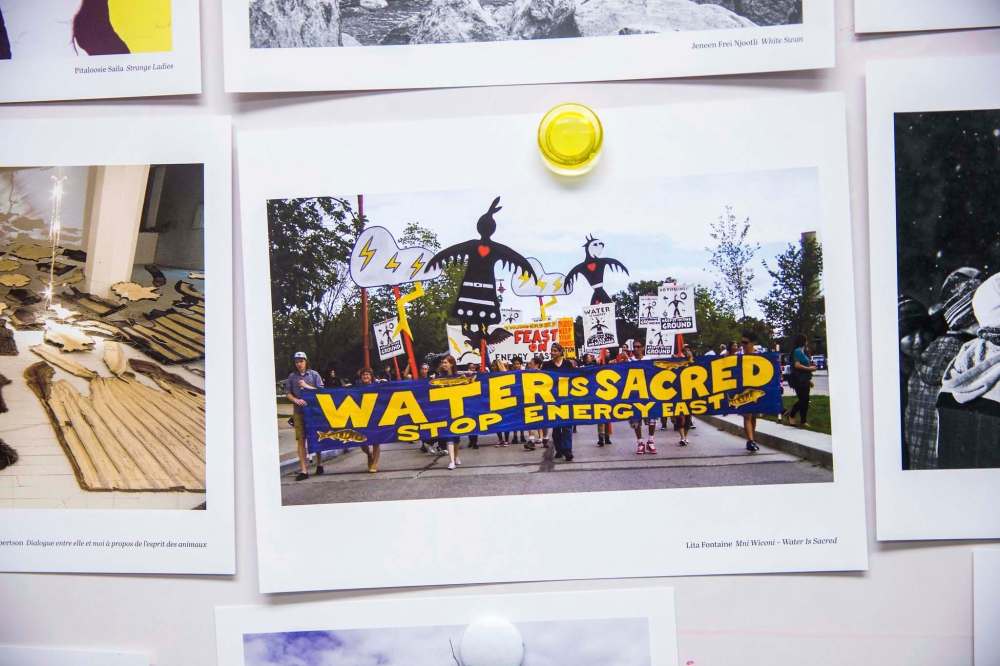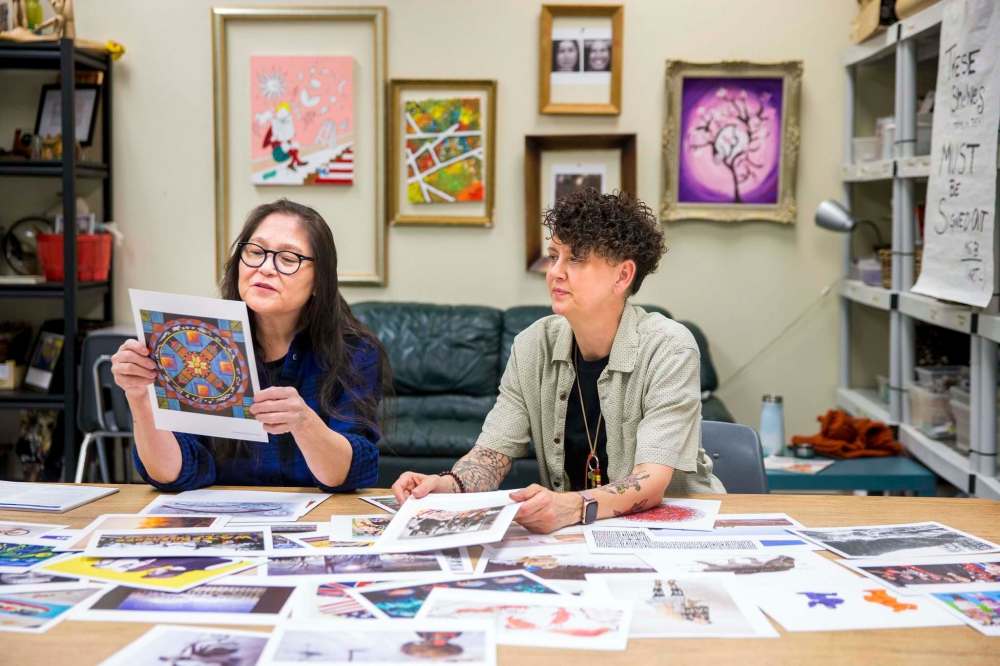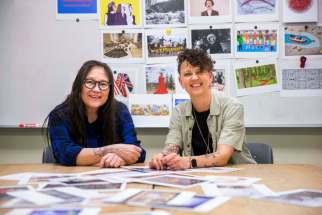Dealing a new hand Teaching tool uses Indigenous art cards to start a conversation about reconciliation, contemporary issues
Read this article for free:
or
Already have an account? Log in here »
To continue reading, please subscribe:
Monthly Digital Subscription
$0 for the first 4 weeks*
- Enjoy unlimited reading on winnipegfreepress.com
- Read the E-Edition, our digital replica newspaper
- Access News Break, our award-winning app
- Play interactive puzzles
*No charge for 4 weeks then price increases to the regular rate of $19.00 plus GST every four weeks. Offer available to new and qualified returning subscribers only. Cancel any time.
Monthly Digital Subscription
$4.75/week*
- Enjoy unlimited reading on winnipegfreepress.com
- Read the E-Edition, our digital replica newspaper
- Access News Break, our award-winning app
- Play interactive puzzles
*Billed as $19 plus GST every four weeks. Cancel any time.
To continue reading, please subscribe:
Add Free Press access to your Brandon Sun subscription for only an additional
$1 for the first 4 weeks*
*Your next subscription payment will increase by $1.00 and you will be charged $16.99 plus GST for four weeks. After four weeks, your payment will increase to $23.99 plus GST every four weeks.
Read unlimited articles for free today:
or
Already have an account? Log in here »
Hey there, time traveller!
This article was published 06/03/2020 (2104 days ago), so information in it may no longer be current.
When elementary teacher Barb Bottle asked her art class at Margaret Park School what they knew about Indigenous artists, she was surprised by the response.
A student raised their hand and explained, bashfully, that Indigenous people were the first people of Canada, but they weren’t alive anymore.
“It was shocking,” Bottle says. “Even when you think you’re doing a really good job, you ask a little child a question and they come up with a very honest answer that makes you realize there’s still more to do.”
The exchange happened while Bottle was teaching a lesson based on the Resilience: 50 Indigenous Art Cards and Teaching Guide published by Mentoring Artists for Women’s Art (MAWA). Since last November, the organization has distributed the bilingual teaching tool kit free of charge to every public school in Winnipeg and every band school and rural school district in Manitoba.

The goal is to start a dialogue among school-aged kids about contemporary Indigenous issues and realities — which is exactly where the conversation went in Bottle’s classroom.
Each set contains 50 full-colour prints and an in-depth teaching guide based on MAWA’s 2018 exhibition Resilience, which was curated by Lee-Ann Martin and saw artwork by 50 contemporary First Nations, Inuit and Métis women displayed on billboards across the country.
“It positioned contemporary Indigenous women’s art in the public eye, specifically in inner cities and on highways from which so many women have disappeared,” says Shawna Dempsey, MAWA’s co-executive director.
The idea to turn the exhibition into a teaching tool came from conversations with Manitoba educators.
“Teachers started telling us, yes, I would like to integrate Indigenous perspectives, Indigenous histories in the classroom, but as a non-Indigenous person, I’m not sure how to do that or I’m afraid of causing offence,” Dempsey says.
The project came together in just nine months after MAWA secured funding from the Winnipeg Foundation, the province and the Manitoba Association for Art Education. So far, the organization has spent $70,000 on publication and distribution within Manitoba and is starting to promote the tool kit across Canada.
“The goal is to get them in classrooms any way we can do that,” says Dempsey, adding that the kits can also be purchased by the public for $40.
For Bottle, who is a visual artist and vice-chairwoman of MAWA’s board, the Resilience cards have provided an easy way to introduce contemporary art and Indigenous perspectives to her students, who range from kindergarten to Grade 5.

“I’m trying to bring it into the now, as opposed to the ‘old dead white guys’ way that art has been taught. I mean, how many Starry Night (by Vincent van Gogh) reproductions can be done?” she says. “Through these cards… we can say this is what’s happening right now and this is how these artists are responding to it.”
The topics explored in the Resilience kit are wide-ranging — from residential schools to treaties to family history to racism — and the material can be modified for different grade levels.
Bottle’s approach has been to start with artwork that deals with tangible things, such as environmental issues, before moving on to heavier topics such as missing and murdered Indigenous women and girls.
“A lot of this stuff is pushing boundaries and it’s pushing them harder if you’re nine years old, but I really like going there with kids,” she says. “They can handle it.”
Lita Fontaine is an artist-in-residence with the Seven Oaks School Division and one of the artists featured in the original Resilience exhibition.
“I like the term resilience,” says Fontaine, who is Anishinaabe, Dakota and Métis. “For me it’s bouncing back and facing the hardness we had in our life and springing back and standing up again… I learned that from my mother and I think as an Indigenous woman it’s in us because we survived for the past 500 years.”
Her submission was a photograph of pipeline protesters taken at The Forks in 2016, entitled Mni Wiconi — Water Is Sacred.
“At the time I was photographing and speaking about water issues,” Fontaine says. “I’m a sun dancer, so I know the sacredness and the importance of water. (By) sacrificing water for four days I realize how sweet and beautiful it is to have. If we didn’t have it, we would die.”
Fontaine has helped Seven Oaks teachers incorporate art into the curriculum for 20 years. During that time, she has seen Indigenous education gain prominence in the division.

“We have sweat lodges here in our division, we have three elders in our community,” she says. “When I started there was nothing like that; we really moved it forward.”
Fontaine is one of the authors of the teaching guide that accompanies the Resilience art cards. The guide is informed by the Truth and Reconciliation Commission’s calls to action on education and includes background information about the artists and their work, as well as ways to promote classroom activity.
“The idea is to get the voices and the visuals in the classroom to enhance their learning about contemporary and historical issues,” she says.
While the Resilience kit is a substantial resource for teachers who have time to get acquainted with the material, both Fontaine and Bottle worry the boxes could be overwhelming for the uninitiated.
“I’m an artist, I’m a teacher, I know this project because I’m connected to MAWA, so of course I opened it up,” Bottle says. “But it does need followup.”
MAWA has hosted one workshop on the tool kit for teachers and plans to offer more as needed. Schools can also contact the organization to sign up for an in-house training seminar.
MAWA is hosting its annual Over the Top Art Auction and Cupcake Party fundraiser later this month at The Edge Gallery, 611 Main St. The silent auction will feature work by more than 150 established and up-and-coming artists. Bidding runs from March 20 to 22, with a cupcake party from 1 to 5 p.m. on the final day of the auction. Tickets are $10 in advance at mawa.ca and $12 at the door.
eva.wasney@freepress.mb.ca
Twitter: @evawasney

Our newsroom depends on a growing audience of readers to power our journalism. If you are not a paid reader, please consider becoming a subscriber.
Our newsroom depends on its audience of readers to power our journalism. Thank you for your support.








